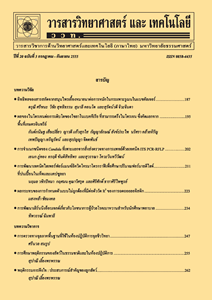การเปรียบเทียบวิธีการประมาณค่าพารามิเตอร์ด้วยวิธีเบย์เซียน วิธีกำลังสองน้อยที่สุด และวิธีบูตสแตรปแบบใช้พารามิเตอร์สำหรับตัวแบบถดถอยเชิงเส้นอย่างง่าย
Main Article Content
Abstract
บทคัดย่อ
งานวิจัยนี้มีจุดประสงค์เพื่อเปรียบเทียบวิธีการประมาณค่าพารามิเตอร์แบบจุดด้วยวิธีเบย์เซียน (Bayesian method) วิธีกำลังสองน้อยที่สุด (ordinary least square method) และวิธีบูตสแตรปแบบใช้พารามิเตอร์(parametric bootstrap method) ในการวิเคราะห์การถดถอยเชิงเส้นอย่างง่าย เกณฑ์ในการพิจารณาประสิทธิภาพของวิธีการประมาณค่า คือ ค่าเฉลี่ยความคลาดเคลื่อนกำลังสองเฉลี่ย (AMSE) ขนาดตัวอย่างที่ใช้ในการศึกษา คือ 15, 30, 75 และ 100 การแจกแจงของความคลาดเคลื่อนสุ่ม คือ การแจกแจงแบบปกติมีค่าเฉลี่ยเท่ากับ 0 และส่วนเบี่ยงเบนมาตรฐานเท่ากับ 0.15, 0.5 และ 1 ตัวแปรอิสระเป็นค่าคงที่ซึ่งสุ่มมาจากการแจกแจงปกติด้วยค่าเฉลี่ยเท่ากับ 1 และส่วนเบี่ยงเบนมาตรฐานเท่ากับ 0.1 ข้อมูลที่ใช้ในการวิจัยได้จากการจำลองข้อมูลด้วยเทคนิคมอนติคาร์โลกระทำซ้ำ 1000 ครั้งในแต่ละสถานการณ์ ซึ่งผลการวิจัยสรุปได้ดังนี้ วิธีเบย์เซียนมีประสิทธิภาพดีที่สุดสำหรับทุก ๆ สถานการณ์ที่กำหนด รองลงมาคือวิธีกำลังสองน้อยที่สุดและวิธีบูตสแตรปแบบใช้พารามิเตอร์มีประสิทธิภาพใกล้เคียงกัน
คำสำคัญ : การแจกแจงแบบปกติ; ค่าเฉลี่ยความคลาดเคลื่อนกำลังสองเฉลี่ย; การประมาณค่าพารามิเตอร์แบบจุด
Abstract
The objective of this research is to compare three methods of point estimation: Bayesian method, ordinary least square method and parametric bootstrap method for the simple linear regression model. The criterion is the average mean squared error (AMSE) and the sample sizes are 15, 30, 75 and 100. The distribution of error term is normal with mean of 0 and standard deviation of 0.15, 0.5 and 1 and the independent variable is selected at random from normal distribution with mean of 1 and standard deviation of 0.1. The data is generated by using the Monte Carlo technique with the repetition of 1000 times. It is found that the Bayesian method is the most efficient, followed by the ordinary least square method and the parametric bootstrap method, respectively.
Keywords: normal distribution; average mean squared error; point estimation


